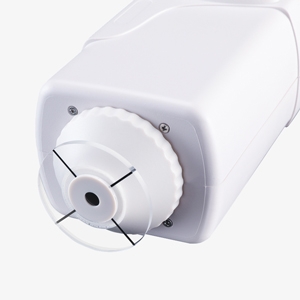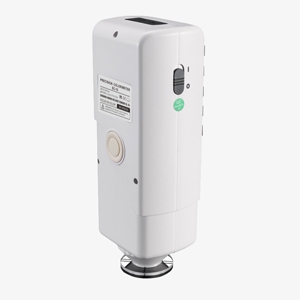4mm handheld caliber colorimeter has a beautiful, smooth shape and comfortable grip, in line with the structure of the human body mechanics design, fit the palm for continuous testing work, so you can use it quickly and easily.
Note: This colormeter cannot transmit data or perform any other functions with computer software. The USB port is only for charging purposes.

Dual positioning measurement
- 4mm measuring aperture.
- Dual positioning of light and cross, suitable for multiple applications.

Switch and button
- I stand for on, O stands for off, and the interface can be operated by direct charging with a power adapter.
- Ergonomic design with a soft rubber button on the back of the machine.
Application
The colorimeter can easily achieve accurate color transmission and can also be used as precision color testing equipment. It is widely used in plastic, electronics, paint, ink, textile and garment, printing and dyeing, printing paper, automotive, medical, cosmetic and food industries, research institutes, schools and laboratories.
| Model | SISCO-CM-SC-10 |
| Illuminating/Viewing Geometry | 8/d |
| Measuring Aperture | φ4mm |
| Errors Between Each Equipment | ≤0.20E*ab |
| Repeatability | ≤0.03 E*ab Measure white standard version 30 times average |
| Detector | Silicon photoelectric diode |
| Locating | Illuminating Locating/Cross Locating |
| Measurement End Face | Large stable end-face and small concave-convex end-face |
| Color Space | CIEL*a*b |
| Color Difference Formula | E*ab, |
| Light Source | D65 |
| Light Source Device | LED blue light excitation |
| Weight | 500g |
| Power source | Rechargeable lithium-ion battery 3.7V@3200mAh |
| Lamp Life | 5 years, more than 1.6 million measurements |
| Charging Time | 8 hours--100% electricity |
| Connector | USB |
| Operating Environment | 0~40℃(32~104°F) |
| Dimension | 205*70*100mm |
Note: The user can perform black-and-white calibration through the standard black-and-white box of the instrument and refer to the user manual to complete the calibration independently.
Packing List
- 1 x Colorimeter
- 1 x Power adapter
- 1 x Manual
- 1 x Wristband
- 1 x Φ4 Platform measuring diameter
Q1: How does a color meter work?
A1: Color meters rely on the concept of the Beer-Lambert law, which assumes that the absorbance of a substance is proportional to its concentration. For example, the higher the concentration of a solution, the higher the absorbance reading. Many chemical and biological experiments are based on this concept. To obtain a Beer's law curve, several standards (solutions of known concentration) are prepared and their absorbance values are determined using a colorimeter.
Q2: What is colorimetry?
A2: A colorimeter is a device that measures light absorbance (how much light is absorbed) and light transmission (how much light passes through) in a liquid by analyzing the intensity of the color.
Q3: What are the limitations of a color meter?
A3: One limitation of chemical color meters is that differences in certain substances may lead to inaccurate test results. According to Global Water Instrumentation, because these differences are different for each substance, a chemical colorimeter alone is not a completely foolproof testing device.
Tips: What does the LAB in a colorimeter mean?
L, A, and B on a colorimeter are chromaticity values representing the color of an object, i.e. the color space coordinates of a color. Any color has a unique coordinate value, where L stands for luminance (black and white), and A stands for red and green. B stands for yellow and blue. Using a colorimeter, the three groups of data L, a, and b, and the colorimetric △E, △L, △a, and △b color difference data are generally output. △E total color difference, △L+ means bright, △L- means dark, △a+ means reddish, △a- means greenish, △b+ means yellowish and △b- means blueish.
Thank you for buying industrial test and measurement equipment on SISCO.com, all products sold by SISCO and the partner cover a 12 months warranty, effective from the date of receiving the products.
What is covered?
SISCO is responsible for providing free spare parts, and free technical support to assist the customer to repair the defective products until the problem is solved.
What is not covered?
- Product purchased from anyone other than a SISCO store or a SISCO authorized reseller.
- Expendable parts.
- Routine cleaning or normal cosmetic and mechanical wear.
- Damage from misuse, abuse or neglect.
- Damage from use of parts other than SISCO approved.
- Damage from use outside the product’s usage or storage parameters.
- Damage from use of parts not sold by SISCO.
- Damage from modification or incorporation into other products.
- Damage from repair or replacement of warranted parts by a service provider other than a SISCO authorized service provider.
- Damage caused by the application environment not meeting the product usage requirements and the failure to perform preventive maintenance.

